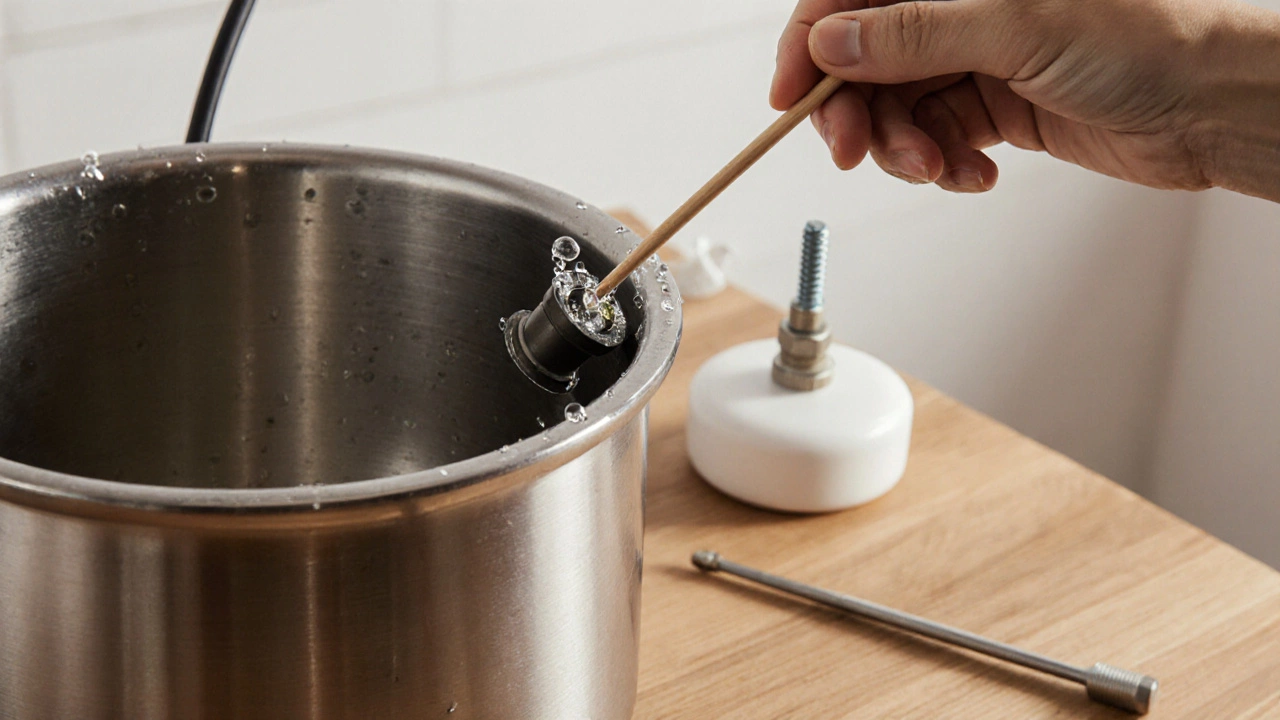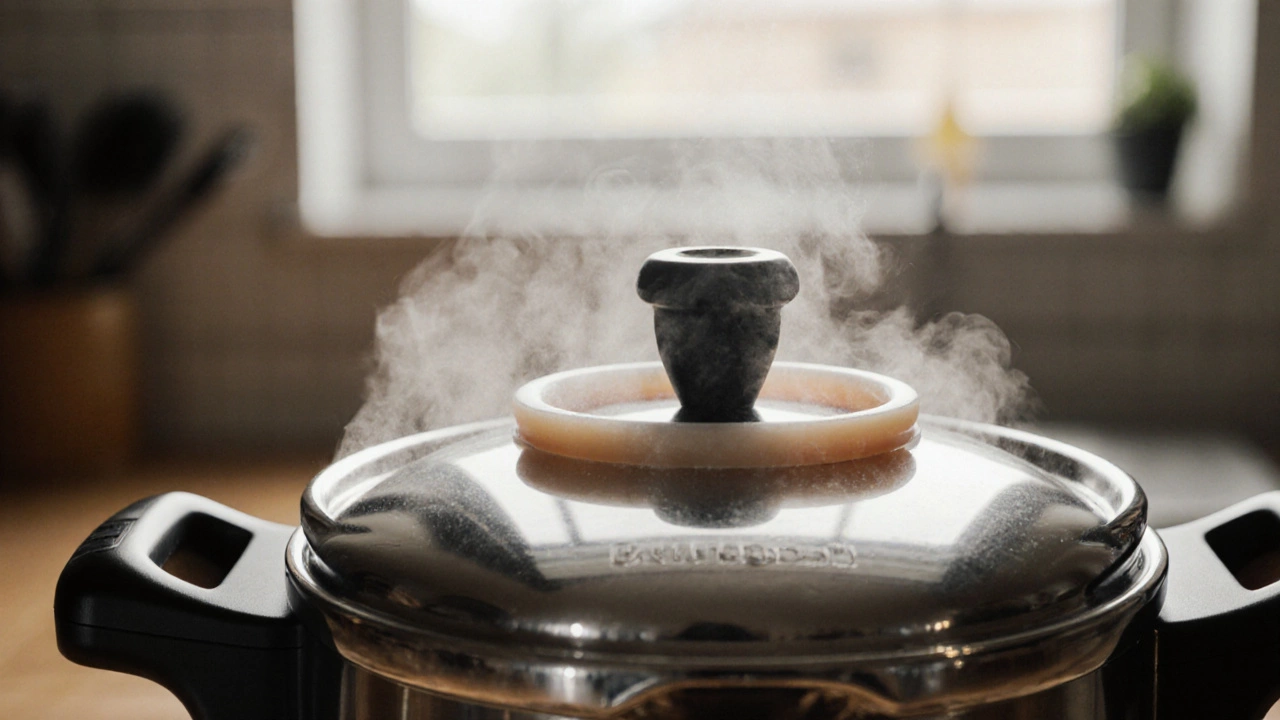Pressure Cooker Repair Calculator
Can You Repair It?
Determine if it's worth fixing your pressure cooker based on your specific issue and cost.
Most people treat their pressure cooker like a black box-until it stops working. Maybe the lid won’t seal. Maybe steam hisses from the handle. Or worse, the cooker won’t build pressure at all. You stare at it, wondering: can a pressure cooker be repaired? Or is it time to toss it and buy a new one?
The short answer? Sometimes. But not always. And it’s not just about money-it’s about safety.
When Repair Makes Sense
Pressure cookers are built with replaceable parts. The most common failures aren’t the inner pot or the heating element-they’re the little things that wear out fast. A worn-out gasket, a clogged steam vent, a loose handle screw. These aren’t signs of a broken cooker. They’re signs of normal use.
Take the sealing ring. It’s made of silicone or rubber and lasts about 12 to 18 months with regular use. If your cooker leaks steam or won’t build pressure, the ring is almost always the culprit. Replacing it costs under $15 and takes five minutes. Most manufacturers sell them directly. Even older models from 2010 still work fine with a new ring.
Same goes for the pressure release valve. If it’s stuck or clogged with food bits, it won’t vent properly. That’s dangerous. But cleaning it with a toothpick and vinegar usually fixes it. Some models have removable valves you can swap out for under $10. You don’t need a technician for this.
Loose handles or cracked outer shells? If the damage is minor-a hairline crack in the plastic housing, a wobbly latch-you can often glue or tighten it. But if the metal body is dented, warped, or has deep scratches near the sealing surface, stop. That’s not a repair job. That’s a fire hazard.
When Repair Is a Bad Idea
Some failures can’t be fixed safely. And if you’re tempted to jury-rig them, you’re risking more than a ruined meal.
The safety valve is the most critical part. It’s designed to blow open if pressure gets too high-like a failsafe. If it’s damaged, corroded, or has been tampered with, replacing it isn’t enough. The whole pressure system needs calibration. Most home repair shops don’t have the tools to test that. And even if they did, the cost of labor would be close to the price of a new cooker.
Electrical pressure cookers (like Instant Pots) are another story. If the control board fries, you can’t just swap it out like a lightbulb. These boards are custom-made, sealed, and often soldered. A replacement board costs $50-$80. Labor? Another $40-$60. You’re now spending $100 on a cooker that originally cost $80. And even then, there’s no guarantee the new board won’t fail again in six months.
And then there’s the inner pot. If it’s scratched, pitted, or warped from overheating, it won’t heat evenly. That’s not just a cooking problem-it’s a safety issue. Warped pots can’t seal properly. Steam escapes. Pressure builds unevenly. The risk of explosion isn’t high, but it’s real. No reputable repair shop will touch a warped inner pot.
What Parts Can You Replace Yourself?
Here’s what you can safely fix at home, with tools you already own:
- Sealing ring - Remove the old one, pop in the new one. No tools needed.
- Steam vent valve - Unscrew, clean with vinegar and a toothpick, reassemble.
- Pressure indicator pin - If it’s stuck up, it’s blocked. Clean the hole underneath with a pin.
- Lid latch or handle screws - Tighten with a Phillips screwdriver. If they’re stripped, replace them ($5 for a kit).
- Outer lid gasket - Found on older models. Same process as the sealing ring.
Most pressure cookers come with a manual that shows how to disassemble these parts. If you lost it, search online for your model + “parts diagram.” Brands like Fagor, Instant Pot, and Cuisinart have downloadable manuals on their sites.
Order parts directly from the manufacturer. Don’t buy generic rings from Amazon. They might fit, but they’re often made with lower-grade silicone that degrades faster or doesn’t seal properly. A $12 genuine ring lasts twice as long as a $5 knockoff.

Why Most Repair Shops Won’t Touch It
Here’s the truth: most appliance repair shops won’t fix pressure cookers. Not because they can’t-but because they won’t take the liability.
A pressure cooker failure can cause serious injury. If a technician repairs it and it explodes later, they could be sued. So most shops have a simple policy: if it’s not worth replacing, they won’t touch it.
Even if you find a shop that says they can fix it, ask this: “Do you test the pressure safety valve after repair?” If they say no, walk away. If they say yes, ask how they test it. If they say “we use a gauge,” that’s not enough. Proper testing requires a calibrated pressure chamber. Few shops have one.
Most repairs are just cleaning or part swaps. That’s fine. But if the repair involves adjusting internal pressure systems, you’re better off buying new.
How to Decide: Repair or Replace?
Ask yourself these three questions:
- Is the cooker less than five years old? If yes, and the issue is a seal or valve, repair it.
- Is the repair cost more than half the price of a new one? If yes, replace it.
- Is the inner pot damaged or warped? If yes, replace it. No exceptions.
Here’s a quick cost comparison for a typical 6-quart electric pressure cooker:
| Item | Cost | Time |
|---|---|---|
| New sealing ring | $12 | 5 minutes |
| New steam valve | $15 | 10 minutes |
| Professional repair (labor + parts) | $70-$120 | 2-3 days |
| New pressure cooker (basic model) | $80-$100 | Instant |
If you’re spending more than $50 to fix it, you’re better off buying a new one. Modern pressure cookers are safer, more efficient, and come with better safety features than models from five years ago.

What to Look for in a New One
If you’re replacing it, don’t just grab the cheapest one. Look for these features:
- Multiple safety mechanisms - At least three: lid lock, pressure release valve, overpressure plug.
- Stainless steel inner pot - Avoid nonstick coatings. They scratch, and scratches = uneven heating.
- Clear pressure indicator - You should be able to see when it’s pressurized without guessing.
- Brand with parts available - Instant Pot, Fagor, Ninja, and Cuisinart all sell replacement parts for 5+ years.
Buy from a retailer with a good return policy. Test it at home before committing. Run a water cycle without food. Listen for hissing. Check the lid seal. Make sure the pressure indicator rises smoothly.
Final Thought: Safety First
Pressure cookers are powerful tools. They’re not toys. A cracked lid, a faulty valve, or a warped pot can turn your kitchen into a hazard zone. Even if you’re handy, don’t gamble with pressure.
Fix the small stuff. Replace the gasket. Clean the valve. But if the cooker is old, damaged, or the repair costs more than half the price of a new one-walk away. A new cooker isn’t just a replacement. It’s an upgrade in safety, efficiency, and peace of mind.
And if you’re still unsure? Call the manufacturer. Most have free helplines. They’ll tell you if your model is repairable-or if it’s time to let it go.
Can I fix a pressure cooker myself?
Yes, if the issue is a worn sealing ring, clogged steam vent, or loose screw. These are simple, low-risk fixes you can do in minutes with basic tools. But never attempt to repair the pressure valve, control board, or warped inner pot yourself. Those require professional calibration and testing.
Is it cheaper to repair or replace a pressure cooker?
If the repair costs more than half the price of a new cooker, replace it. Most common fixes-like a new sealing ring-cost under $15. Professional repairs can run $70-$120. A new basic model starts at $80 and comes with updated safety features.
How long do pressure cooker seals last?
Silicone sealing rings typically last 12 to 18 months with regular use. Signs they need replacing include steam leaking from the lid, failure to build pressure, or a cracked, brittle ring. Replace them every year as preventative maintenance, even if they still look fine.
Can a pressure cooker explode?
Modern pressure cookers have multiple safety valves and won’t explode under normal use. But if the safety valve is clogged, the lid is forced open, or the inner pot is warped, pressure can build dangerously. Always follow the manufacturer’s instructions and never override safety features.
What should I do if my pressure cooker won’t seal?
First, check the sealing ring. Remove it, clean the groove in the lid, and inspect the ring for cracks or warping. Replace it if needed. Also check that the lid is properly aligned and the pressure release valve is in the sealed position. If it still won’t seal, the inner pot may be warped or the lid latch damaged-time to replace the unit.

